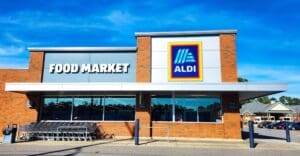Aldi has become the unlikely star of the US grocery sector, with Americans flocking to the German discounter in record numbers as high inflation reshapes shopping habits.
Queues for new product releases – once associated with sneaker drops and tech launches – are now a familiar sight outside Aldi stores across the Midwest and beyond. From wine bottle advent calendars to limited-edition snacks, shoppers say the chain has built a cult-like following while positioning itself as the country’s fastest-growing supermarket.
Ashley Williams, a mother of four in Illinois, says her local Aldi is transformed into an event destination whenever new products are released. “There’ll be such a line that they give out tickets,” she says. “We’re in the Midwest, and it’s pretty cold in the fall, but people still turn out.”
Williams turned her love for the retailer into an Instagram account, Oh Hey Aldi, which now has 173,000 followers. She is part of a growing community of influencers – including Aldi All The Time and the Aldi Nerd Facebook group with 1.4 million members – fuelling sales of branded merchandise and building a loyal fanbase.
Aldi has operated in the US since the 1970s, but its real growth push has come in the past decade. Since 2014, the retailer has doubled its footprint and now runs more than 2,500 stores across 40 states. According to JLL, Aldi is expanding at more than twice the pace of its nearest competitor, with plans to open 225 stores in 2025 and 800 more by 2028 – taking its US estate past 3,200 outlets.
“In our modern supermarket era, I haven’t seen anything like this,” says James Cook, senior director of US retail research at JLL. Dave Rinaldo, Aldi’s US chief operating officer, adds: “We literally can’t open the stores fast enough.”
Between 2019 and 2024, US food prices rose nearly 24 per cent. While grocery footfall increased 11 per cent across the industry, Aldi’s surged more than 51 per cent, according to JLL data. Last year, its stores attracted 924 million visits, making it the third-most visited supermarket in America after Kroger and Publix.
Shoppers are not just turning to Aldi for price. The retailer’s policy of stocking mostly own-brand products – many free from artificial dyes and additives – has struck a chord with health-conscious families. “It’s kind of a relief to walk into a store and know you don’t have to scan every label just to stay within budget,” says Williams.
Aldi’s success lies in its no-frills model. Stores typically stock around 2,000 products – compared with 31,000 in a typical US supermarket – and nearly 90 per cent are own-brand. Goods are displayed in pallets and boxes to save staff time, while the smaller store footprint keeps rent and energy costs down.
A study by AARP found a typical Aldi basket costs around $66.11 (£49.25), roughly 20 per cent less than rival discounter Target.
Even as inflation pressures ease, the threat of fresh price rises from Donald Trump’s renewed trade war agenda is expected to keep Americans focused on value. Aldi is moving to capture more market share, launching summer price cuts on more than 400 items.
For many consumers, less choice and lower costs have become a welcome combination. “It’s nice to not have excessive amounts of things to choose from,” says Sarah Campbell, a New Jersey teacher and Aldi influencer. “Especially when you’re worried about your economic future, you look for savings wherever you can.”
With nearly one billion annual US store visits and an aggressive pipeline of openings, Aldi’s march on America looks set to continue – one stripped-down shopping basket at a time.
Read more:
Americans embrace Aldi as German discounter becomes fastest-growing supermarket in US
